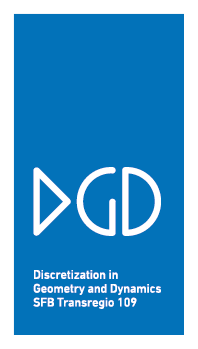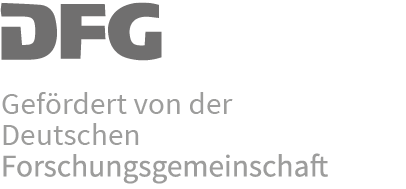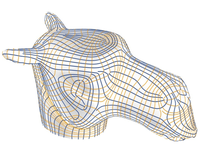Construction of Curved Support Structures
Pengbo Bo, Martin Kilian, Helmut Pottmann, Jonas Schikore, Eike Schling, Chengcheng Tang, Johannes Wallner, Hui WangDescription
Curved beams along freeform skins pose many challenges, not least on the level of basic geometry. A prototypical instance of this is presented by the glass facades of the Eiffel tower pavilions, and the interrelation between the differential-geometric properties of the glass surface on the one hand, and the layout of beams on the other hand. Shown is how curved beams are represented by developable surfaces, and studies geometric facts relevant to beam placement along guiding surfaces. Surprisingly, many of the curves which are interesting from the viewpoint of pure geometry (geodesics, principal curves, etc.) occur in this context too.
Shown are recent advances in the modeling of developable surfaces, and how they permit the interactive design of arrangements of curved beams, in particular the design of so-called geometric support structures.
Furthermore the fabrication and construction of curved beams along freeform skins is a demanding task related to their individual and complex geometry. One strategy to simplify the fabrication process uses elastic deformation to construct curved beams from flat elements. Controlling the curvature of the design surface and beams has the additional potential to create repetitive building parts with beneficial beam orientation.
An option is to aim for strained gridshells built entirely from straight or circular lamellas of the same radius and with orthogonal nodes. The lamellas are aligned normal to a reference surface enabling an elastic assembly via their weak axis and a local transfer of loads via their strong axis.
Shown was that the corresponding reference surfaces are of constant mean curvature and that the network of beams bisects principal curvature directions. A new discretization of these networks as quadrilateral meshes with spherical vertex stars was introduced and presented is a computational workflow for the design of such structures.
The geometric advantages of these networks were key for the fabrication and assembly of a prototype structure, the Asymptotic Gridshell. The complete process from design to construction, presents further insights on the symbiosis of geometry, fabrication and load-bearing behavior.
References
-
Chengcheng Tang, Martin Kilian, Pengbo Bo, Johannes Wallner, and Helmut Pottmann.
Analysis and design of curved support structures.
In Sigrid Adriaenssens, Fabio Gramazio, Matthias Kohler, Achim Menges, and Mark Pauly, editors, Advances in Architectural Geometry 2016, pages 8–23. VDF Hochschulverlag, ETH Zürich, 2016.
-
Eike Schling, Martin Kilian, Hui Wang, Denis Schikore, and Helmut Pottmann.
Design and construction of curved support structures with repetitive parameters.
In Lars Hesselgren, Axel Kilian, Samar Malek, Karl-Gunnar Olsson, Olga Sorkine-Hornung, and Chris Williams, editors, Advances in Architectural Geometry, pages 140–165. Klein Publishing Ltd, 2018.
-
Chengcheng Tang, Pengbo Bo, Johannes Wallner, and Helmut Pottmann.
Interactive design of developable surfaces.
ACM Trans. Graphics, 2015. accepted.




















